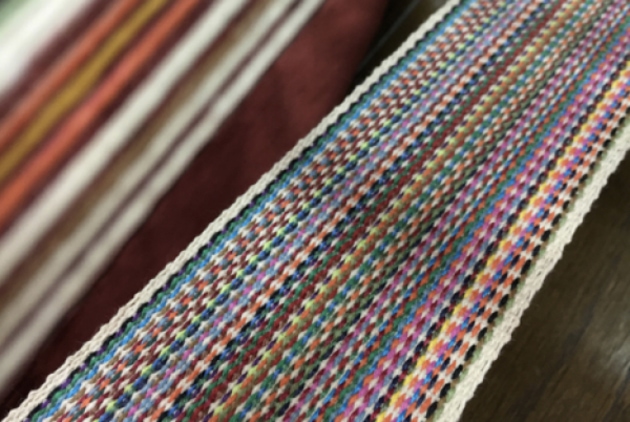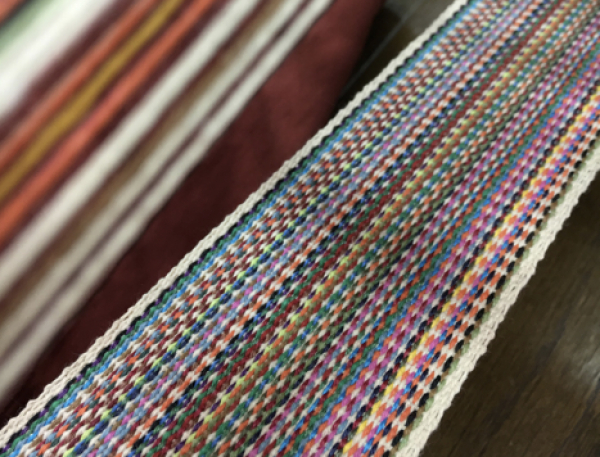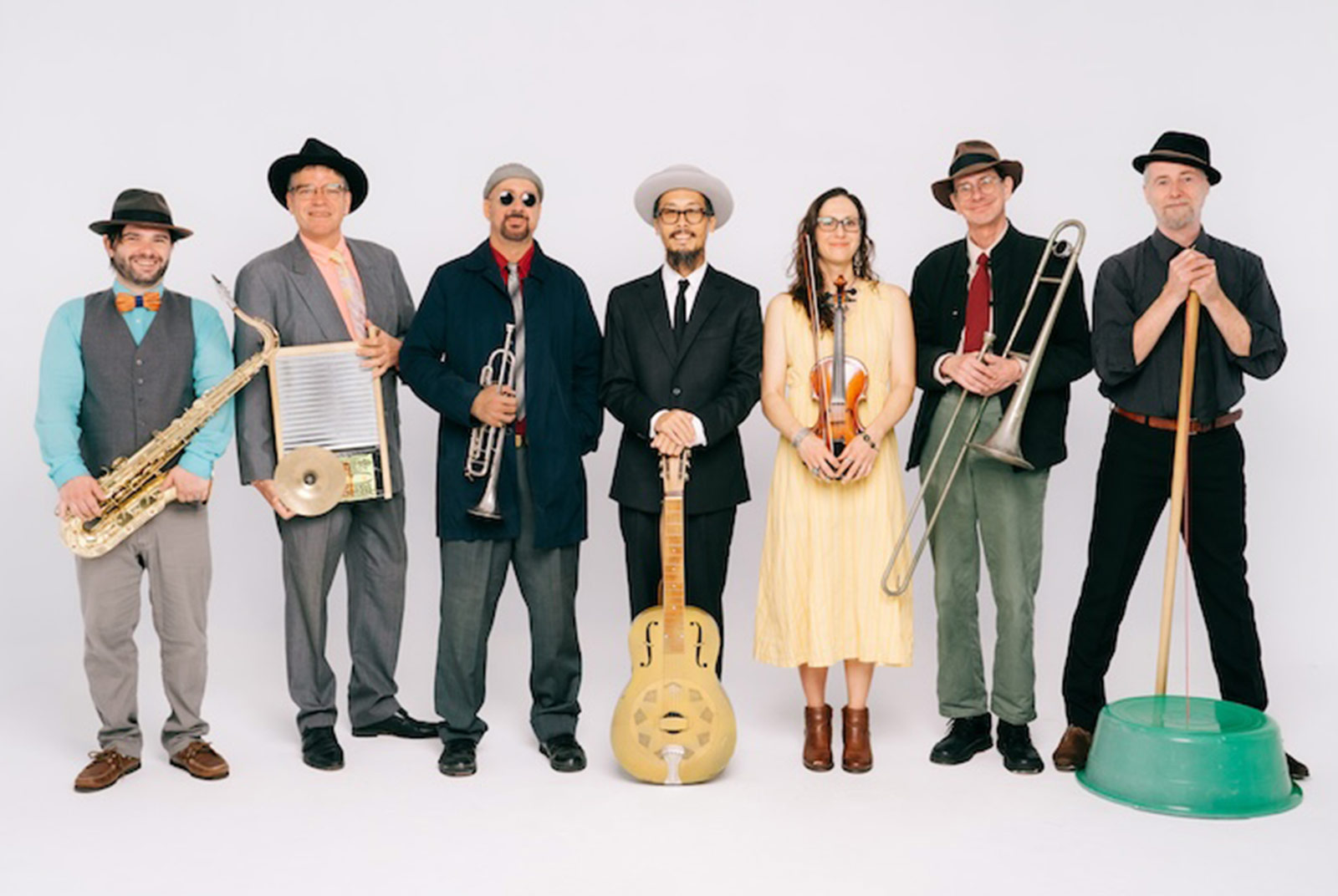Research & Reflections
A Year of Weaving in Taiwan

Source:Fulbright Taiwan
“We don’t have any form of writing at Iwan. This is our true text, a living one, ” says an elderly woman as she prepared food for an Amis festival in Iwan in Taitung county.
Views
A Year of Weaving in Taiwan
By Jennifer Huang/Fulbright Taiwanweb only
It is astonishing to me how quickly these nine months have gone by in Taiwan. This semester in the remote hills of Tainan, where I am a Visiting Artist at Tainan National University of the Arts, my spring has been more introspective, and I am recoiling inwards to access how to best create a work of art in response to my research of indigenous Atayal weaving in the fall, when I was hosted by the Ethnology department at National Chengchi University in Taipei. I have been fearful of being unable to adequately respect and promote the revered weaving process that I have learned. Not being Atayal, I have been afraid of appropriating their patterns to tell a story that was not mine to tell.
I had reservations about researching Atayal culture, since “the term ‘research’ is inextricably linked to imperialism and colonialism. The word itself, ‘research,’ is probably one of the dirtiest words in the indigenous world’s vocabulary,” as Maori anthropologist, Linda Tuhiwai Smith writes in Decolonizing Methodologies: Research and Indigenous Peoples. I have witnessed this skepticism in the Atayal community that I was working with, and I recognize the validity of their concerns. I knew even before I started this fellowship that these would be questions to grapple with.
So I took a brief break from the indigenous loom to ponder these questions by digging into a course reader on Post-colonial Feminism by Fulbright scholar Tricia Lin, while immersing myself in my new surroundings in Tainan. The landscape was so drastically different from Taipei that I gave myself the time to get acquainted and to allow myself to experiment in the studio. The work that resulted was a processed interpretation and by-product of my surroundings.
Repeated colors and shapes naturally found their way into my playful experiments.
When I first got to Tainan, I was excited and overwhelmed by all the equipment and facilities available at the school, and began working in the ceramics studio and weaving on the several different types of looms. My hands sought to make sense of my new surroundings, to provide a kind of bodily understanding for my being here. It is these ideas of how weaving can restore and make sense of a lost past that brought me to Taiwan, and in a manifestation of those feelings, I began creating intuitively without an overarching conceptual narrative in place.
Yet after a couple weeks of working like this, I was aching to draw more direct and meaningful connections to my research in the fall and the work I was exploring at TNNUA. So I returned full-heartedly to the backstrap loom, dedicating my time and energy to developing a project that applied the indigenous ways of weaving.
But first, the sea. Recently, fellow Fulbrighter Alisha Jihn and I were lying by this seashore, talking about “embodied knowledge,” and what it means for us in our prospective fields, for her in dance and dance therapy, and for me in art. For me, I think of embodied knowledge as working through my hands, connecting emotions and thoughts through making. We agreed it was about trusting the body, that embodied knowledge has an intelligence that works in ways that are not always so easy to describe in words. Alisha also added a critical point about listening to your body, listening to your pulse and your breath.
The beach was the perfect place to discuss these notions -- the way your body tells your brain about the variety of sensations experienced, the hot sand lodged in the crevices of your toes, the salt water stinging your eyes as you wiggle your limbs to stay afloat. You bob to the rhythm of the waves, your body becoming a buoy. You feel yourself in sync with the sea.
I like this quote by the physician Havelock Ellis: “We have but to stand on the seashore and watch the waves that beat at our feet, to observe that, at nearly regular intervals, this seemingly monotonous rhythm is accentuated for several beats, that the waves are really dancing the measure of a tune.”
The waves are dancing and so are we. We move to rhythm, feel moved by rhythm, we feel ourselves a part of something larger. I experienced this first-hand when weaving and dancing with the Atayal. I like the way ethnomusicologist Peng Li-Kuo put it: “Aborigine dancing and singing aren’t intended for entertainment and appreciation. You have to experience it, and feel yourself become a part of it.” Beyond aesthetics, this is about belonging.
This belonging can be felt when your movement echoes a lineage of making, of spinning ramie fiber into a thread. I realized this in my first month in Taiwan, when I was learning how to spin ramie with the Atayal in Nan’ao. In this traditional process, we spin using only our bodies, without a drop spindle nor spinning wheel, the tools I am used to using.
The thread becomes a line that I take for a walk, one that I render in my solo show at Haiton Art Center in Taipei, entitled 牽線 漫遊 or to take a line for a walk. The work in the center is called lives spun like thread off a spindle, breakfast time, suppertime, lilac time, apple time. I think about how a life is composed of multiple steps, how it can be a forward trajectory or a meandering walk, and that regardless of what path you take, it is composed of a foot in front of the other. I think of the traditional role of women, housekeeping: how keeping a house is essentially the practice of everyday rituals. I think about what meaningful and important work that is, to keep steady that rhythm of sustaining life.
 Source: Fulbright Taiwan
Source: Fulbright Taiwan
And I think about the women in my family. I think about my great-aunts who were given away after my great grandmother was “cursed” to give birth to a dozen daughters before having a son. I think about my aunt who passed away as an infant in the rice fields because her life wasn’t worth taking to the doctor when she fell sick.
I wish I knew more about the women in my family. “I bet that would be quite a story,” writes Merle Woo, in her prose, Letter to Ma. I wanted to translate these thoughts into cloth. This desire grew into a new project to translate text into textiles. In this first system that I employed, the writing happens when I prepare the warp; it is drawn out before I start to weave. There is a different warp thread and color for each letter, space, and punctuation. When I begin to weave, the sentence coagulates.
“Of all the senses, touch is most linked to emotion and feeling. To be “touched” or “moved” by words implies the process of identification and separation by which we apprehend the world aesthetically,” says Susan Stewart in Poetry and the Fate of the Senses. I want to weave words because, like cloth, words can “touch” and “move.” They can hold you, help to situate you and your sense of identity.
My Atayal teacher in Wulai, Sayun Yuraw, was born when her mother was 46. Sayun was also in her forties, with her first grandchild, when she learned to weave. She brought her grandson, now my English student, to weaving class at Fu Jen University with her. She described the classes as a multi-summer commitment intended for the indigenous community to recover their weaving traditions. Many of them were lost when the Japanese discouraged and then banned weaving, headhunting, and facial tattooing during their colonial occupation of the island.
Since my arrival in Tainan, I have been considering how I will use what I have learned about Atayal weaving to create a new body of work. Not being Atayal, I was hesitant of appropriating the imagery I had learned, but I wanted to remember the technique -- what felt most important was to hold on to that embodied knowledge passed on to me. My intention is to preserve this ancient craft in my body rather than through my mouth. For that reason, I’ve begun to collect quotes from Atayal weavers about their craft, and I asked Sayun Yuraw to share with me the impetus for her work. In the statements, I am finding a kind of collective and individual comfort, purpose, and identity in weaving.
In my next series of textiles, I use the traditional pick-up technique popular among the Atayal in Nan’ao, where Sayun’s mother lived and where Sayun grew up. I use this technique to write as I weave. Rather than spelling out the sentence in the warp, like in the previous system, I am picking up the sentence as I weave. I am starting off with a rainbow, multi-colored alphabet in the warp and picking up each letter in the weft as it appears in the sentences. As I weave, I pick up the group of warp threads that correspond to each letter that I encounter. The result is a float of untethered warp threads at the place of the letter. The completed tapestry begins to look like a punch card for a music box, the letters like musical notes.
“Crossing the Rainbow Bridge” is a phrase used by the Atayal to represent the passage into the heavens where their ancestors dwell after death.
In the past, this transcendence was secured by facial tattoos, which were awarded when a woman perfected the skill of weaving or a man successfully headhunted. It was said that the ancestors would check your hands before you crossed, to make sure they were dyed red from the beet-like root vegetable, 薯榔 (shou-lang), that was used to dye the woven ramie fibers. It showed you had produced many textiles in your lifetime and fulfilled your duty as a woman. Today, in my interactions with Atayal weavers, I am seeing weaving expressed as the means rather than the price of transcendence.
Sayun tells me, “I like weaving because it reminds me of my mother and makes me feel immersed in the good feelings of my childhood and the kind of warm security my mother felt when weaving. Perhaps it is my mother’s love that has been passed on to me, that I weave.” I have translated her words from Mandarin to English and then into cloth. I want these words to be felt, not just conceptually registered. In addition to Sayun, I have also translated a few other quotes from indigenous weavers.
One cloth reads, “Our ancestors provided motherly grace to us… I too will pass down the heritage by continuing weaving,” from Siwa Yummin.
Another weaver, Gieh-Wen Lin, says, “After my thirtieth birthday, I strongly realized that I am a woman… both as part of a collective identity and an individual.”
My goal through weaving their words was to see if the sentiment felt by the Atayal women while weaving could be experienced through textile, if cloth could be a medium for empathy.
One woven translation reads, “We don’t have any form of writing at Iwan. This is our true text, a living one.” This was spoken by an elderly woman as she prepared food for an Amis festival in Iwan in Taitung county.
Although this quote comes from an Amis woman, whose culture is very different from the Atayal, I enjoyed her idea that language can come in many forms, not only through written word. That is what I want to say by weaving. Text in this case is the passing on of culture, is the persistent re-enactment of the rituals of one’s ancestors. It is that repetition of weaving, of making food, of singing and dancing that reveals something about one’s identity.
I still have a month left at Tainan National University of the Arts, so I imagine turning these swaths of cloth that I have woven on the indigenous loom into a larger blanket. I like the idea of being swaddled in words, the way Luce Irigaray put it -- “a place to coil up in, made from arms or words.” I’m interested in an expanded sense of reading -- I want you to read the blanket by allowing the text to hold you. The impetus to write, to connect to a reader, is made physical through weaving and allowing woven words to wrap around one’s reader.
At the moment, I am also experimenting with natural dyes in my weaving because they reveal a sense of place and provide a locality for the thing bathed in its pigment. I’m inspired by my experience dyeing with Atayal and Seediq weavers using the shou-lang root, native to the mountains of Taiwan. I’m interested in continuing a dialogue with the past, and harnessing that ancient knowledge of using root dyes. I want to use natural dyes because the color is more nuanced than that of commercially dyed thread, and I am also interested in roots because of the metaphorical grounding that they would give my woven text.
As my Fulbright experience is wrapping up, I find myself restlessly trying to plan for the unknown future. I am excited to be showcasing Sayun Yuraw’s weavings at the Textile Society of America’s biennial symposium, The Social Fabric: Deep Local to Pan Global, in September. I appreciate the small opportunities that have arisen, but a part of me is somewhat ridden with anxiety, uncertain of where the next few months may lead. What happens now?
I think of this line from the poet Mary Oliver, “Attention is the beginning of devotion.” Drawing was the first art form I fell in love with. I draw because it is stabilizing, drawing me into the present, to focus my attention on the one thing at hand, to trace the contour of a thing with my eyes and to reproduce that care in graphite. In some ways, this is what the Fulbright Fellowship has been for me, providing the incredible opportunity to devote myself to making and Atayal weaving. It has been one very long, extended drawing.
This past year meditating on ideas of identity has led me to the same conclusions as those drawn by writer Alex Wagner in her book Futureface. Growing up as a mixed race woman, she discusses diving into her ancestry to try to make sense of her identity, though in the end she argues that identity is formed in the present, that you choose your identity, that it is formed by your community, by “the men and the women who touch our daily lives.”
What happens now is attending to the present. Even if the future looms large with questions, I know I will find my footing when I attend to my environment and the breathing beings around me. I feel the edges of myself, my identity, when weaving, when drawing, or engaging in thoughtful conversation. This Fulbright experience has laid a foundation, providing a deep well of inspiration for me to draw upon for years to come.
I’ll end with the quote from Susan Stewart, “To be in contact with an object means to be moved by it -- to have the pressure of its existence brought into a relation with the pressure of our own bodily experience. And this pressure perceived by touch involves an actual change; we are changed and so is the object.”
I feel such gratitude for this Fulbright opportunity and for all the people who became a part of my community this year. I know the Fulbright mission to change lives has definitely been achieved in my own, that I have been changed. It may be presumptive to assume that lives other than my own have been changed, but I’d like to think that to be in contact with another is to touch one another’s lives, to enact, “an actual change; we are changed.”
Edited by Sharon Tseng

The Foundation for Scholarly Exchange (Fulbright Taiwan) is one of 49 bi-national/bilateral non-profit organizations established to administer the Fulbright educational exchange program. For more information on the grants see the Fulbright Taiwan website. Research & Reflections is an online publication of submissions from Fulbright Taiwan grant recipients. We hope that it can help fulfill the Fulbright Taiwan's mission of cross-cultural understanding and knowledge-generation. Read more at Research & Reflections.
About the Author
Jennifer Chen-su Huang is an artist, writer, and object-maker based in Chicago, IL. This past year, she has been researching indigenous Atayal weaving in Taiwan. She holds a M.F.A. in Fiber and Material Studies from the School of the Art Institute of Chicago and a B.A. in Art Practice with a minor in Art History from University of California, Berkeley.






